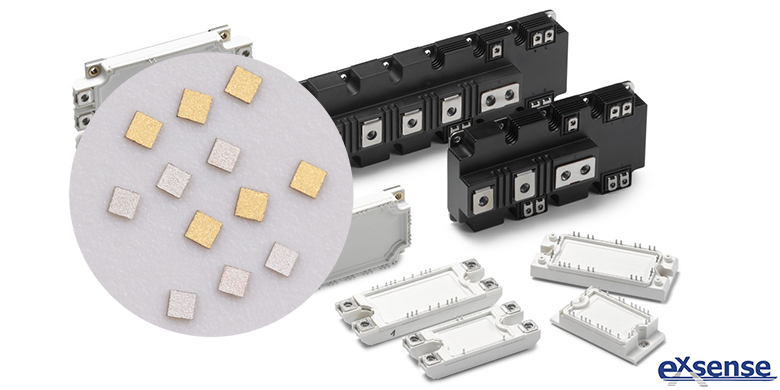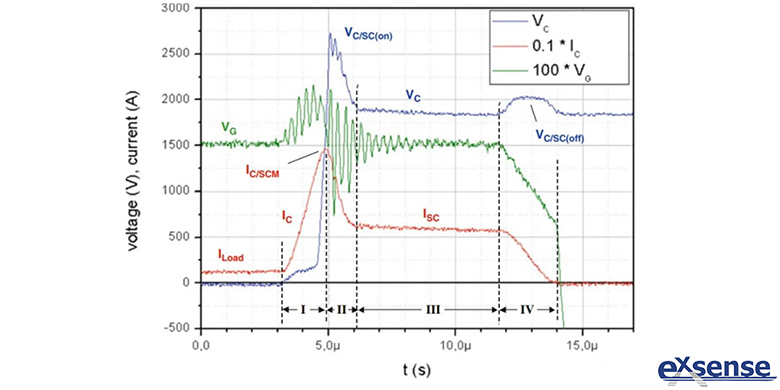
NTC thermistor chip for IGBT produced by EXSENSE Electronics Technology Co., Ltd., has the characteristics of high precision, small volume, fast reaction, etc. It is widely used in IGBT module, infrared thermopile, integrated module, semiconductor module, etc., which plays the role of temperature detection and temperature controlling. What will happen if the IGBT module is broken during the working process?
First, short-circuit behavior in opened transient of IGBT
That is, short circuit fault caused by IGBT opening (the process of gate voltage from negative voltage to positive voltage), that is, before IGBT opening, there is no short circuit fault in the system. The most common short-circuit fault in IGBT is the short-circuit fault when IGBT is turned on. According to the length of desaturation time (depending on the short-circuit loop stray inductance), it can be further divided into type one short circuit and type two short circuit.
Class I short circuit
In the case of class I short circuit in IGBT, the IGBT will enter the desaturation state immediately after opening (it has not yet entered the conducting state). The inductance value of type one short circuit fault circuit is generally dozens of nH, which generally occurs in the straight-through state of the bridge arm.
Class II short circuit
In the case of class II short circuit in IGBT, the IGBT will first enter the saturation conducting state after opening, and then desaturation behavior occurs. The main reason is that the inductance value of the circuit is slightly larger (generally more than 100 nH), and the current climbing speed is a little slower (slower than type one short circuit, but it's still pretty fast).
Class I short circuit and class II short circuit have one thing in common, that is, IGBT appears "desaturation phenomenon". Once IGBT exits the saturation area, its loss will rise hundredfold, so the time allowed to last in this state is very strict, generally within 10 microseconds. It is up to the IGBT gate driver to detect this behavior and turn off the device in time.
Second, short-circuit behavior in on-state process of IGBT
That is, a sudden increase in device current due to external causes when IGBT is on (the gate is open with positive pressure) and the positive guide is on current. Once a short circuit occurs, the IGBT current rises rapidly, and the di/dt rate is determined by the bus voltage and the parasitic inductance of the circuit.

As shown in the figure above, in the stage Ⅰ, IGBT begins to appear undersaturated state, during which the collector voltage of IGBT increases slightly. However, due to the large miller capacitance at this stage, some current will enter the gate due to the effect of dv/dt, leading to an increase in the gate voltage Vge, which will further lead to an increase in collector current. At the end of the stage Ⅰ, the short-circuit current drops to the static value. At this time, due to the effect of the reverse di/dt and the circuit stray inductance, the Vce will have a forward voltage peak Vc/ scon. After the stage Ⅲ, the IGBT is turned off, at which point the soft shutdown or active clamp function of the drive circuit takes effect, limiting the turn-off peak of IGBT to a safe range.
Third, short-circuit behavior during on-state process
That is, the sudden increase of device current caused by external causes when IGBT is on (the gate is open with positive pressure) and the internal fly-wheel diode is on. When a short circuit occurs, IGBT is forced to turn on, similar to the forward recovery process of the diode, IGBT also has a forward recovery, mainly due to the conductivity modulation of bipolar power semiconductor devices takes some time. This forward recovery peak voltage mainly depends on the di/dt speed, which can be up to several hundred volts on the high voltage IGBT in the wide base area (the stray inductance inside the module and the di/dt effect also contribute), and the short-circuit analysis of the waveform and the general process behind the forward peak is basically the same.




